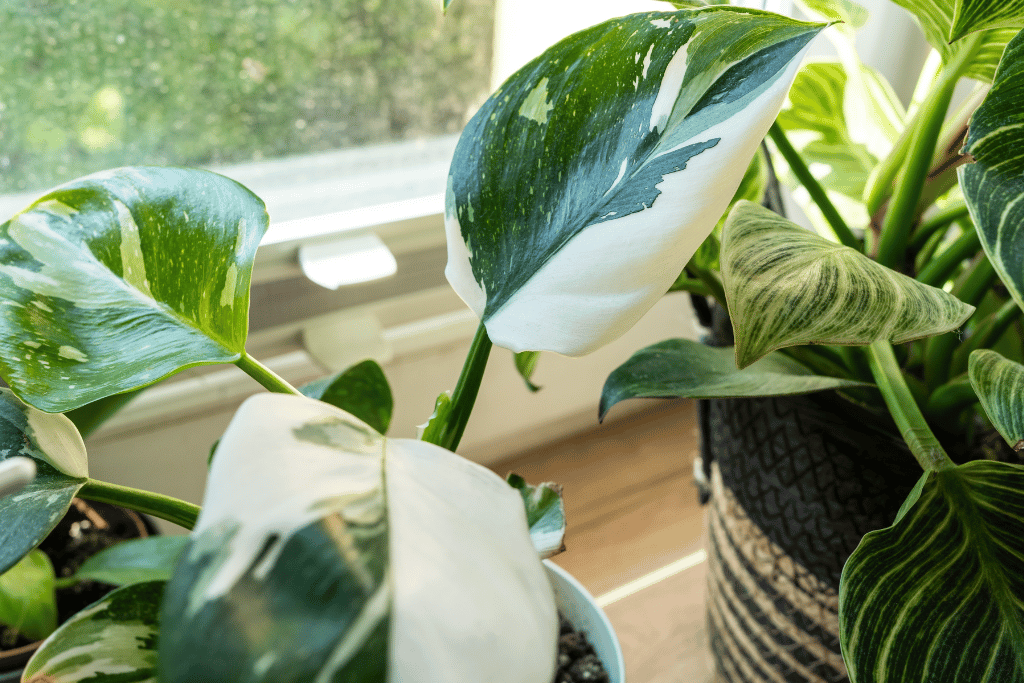The desert rose bonsai kit is becoming quite a popular choice among gardening enthusiasts who would like to get into bonsai or grow their own desert rose bonsai tree and develop it over time. Typically, these kits will include all of the necessary supplies and tools needed to help beginners get started in propagating their own bonsai trees. In this article, we’ll discuss the desert rose bonsai kit in detail, including what it includes, what it is, and how you can develop those lovely trees!
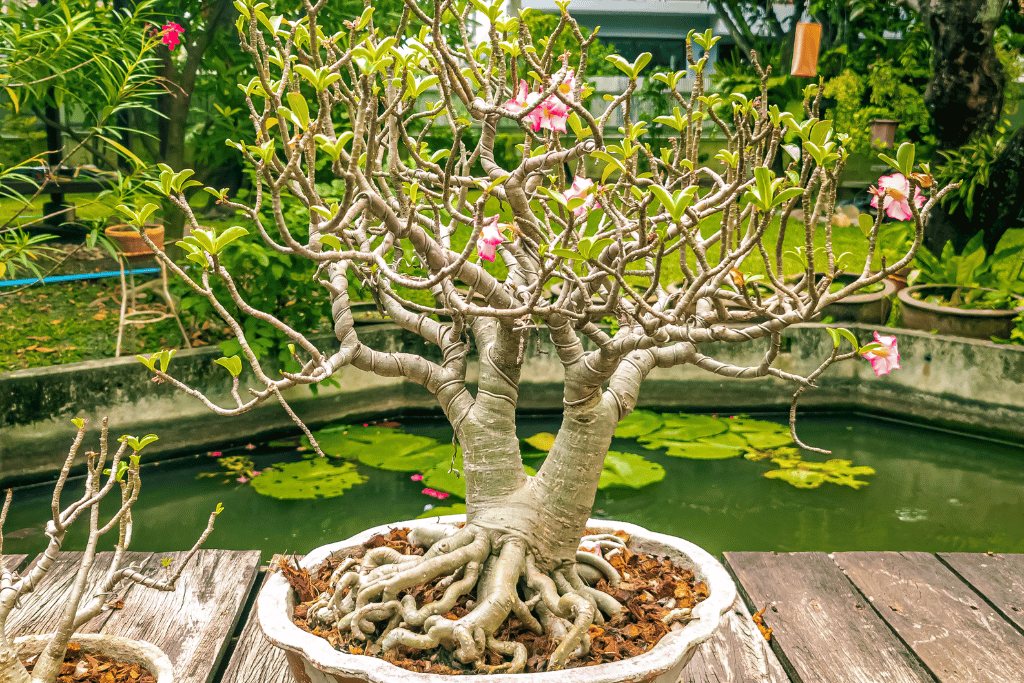
What Is A Desert Rose Bonsai Tree?
Before we delve into propagating desert rose bonsai trees, let’s first understand what one is. The desert rose (Adenium obesum) is a species of flowering plant, which is native to sub-Saharan Africa and the Arabian Peninsula. Most notably, it’s known for its striking flowers and appearance of thick and fleshy stems.
Desert rose bonsai trees are miniature versions of the desert rose plant, grown to be trained in a specific shape or style and kept compact. As a whole, bonsai trees are a traditional Japanese art derived from the Chinese ‘penjing’ style. This includes shaping and pruning trees to create a miniature version of a full-grown tree you would see in nature. These are often meticulously pruned, wired and repotted depending on their stage of growth. Often, you’ll see bonsai trees grown in small pots, which are designed to be displayed indoors at shows.
What is a desert rose bonsai kit?
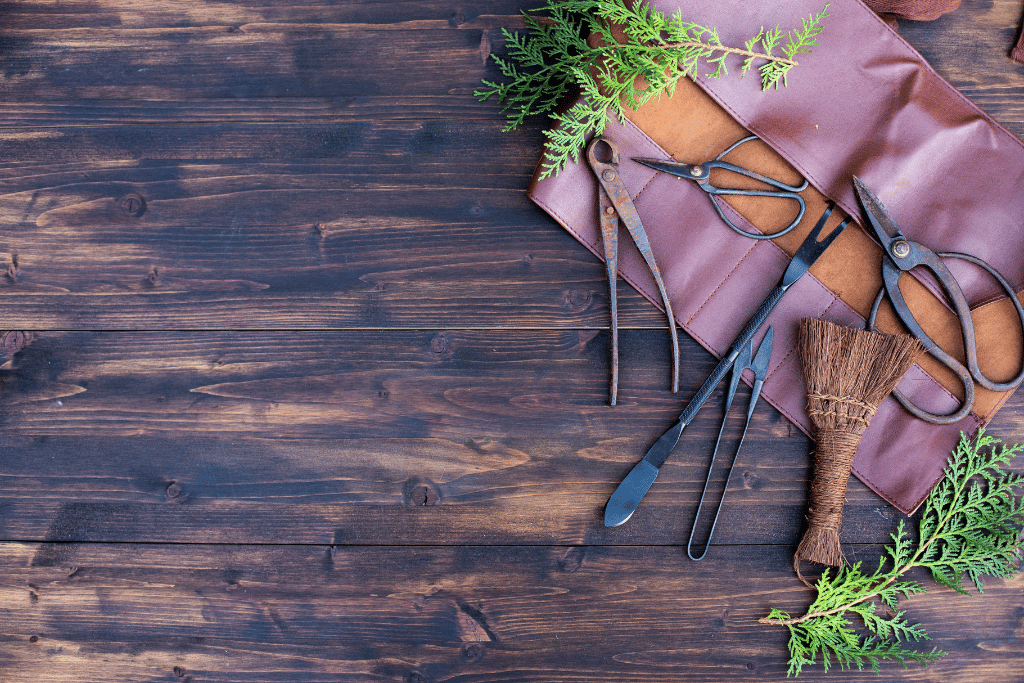
A desert rose bonsai kit is usually a set of tools and supplies which are designed to specifically help beginners grow their own desert rose bonsai tree. They normally include a small pot, soil such as coco coir, pruning shears, wire and a desert rose plant or seeds. Some kits may also include other things such as fertilizer, a humidity tray to keep under your plant, and instructions on how to care for the desert rose bonsai.
The contents of the desert rose bonsai kit will vary depending on the manufacturer – some may include fewer or more tools, and the size of the pot may vary depending on the plant you are supplied with. It’s important to read the product description carefully and know what you’re buying before you purchase it, making sure that it’s giving you everything you need to get started.
Using A Desert Rose Bonsai Kit
Using a desert rose bonsai kit is relatively straightforward, but there are a few things to keep in mind when you’re first getting started with one. Here are the basic steps I would recommend following when using your desert rose bonsai kit:
Step 1) Choose a location for your tree
The first step in using your desert rose bonsai kit is first to choose a location for your bonsai tree to live in. Desert rose plants require bright and direct sunlight to thrive, so it’s important to choose a location that receives plenty of natural light and isn’t shaded. It’s important to keep these plants away from drafts to avoid constant temperature fluctuations, which could harm the plant.
Step 2) Prepare the pot and soil
Once you’ve chosen a desired location for your desert rose bonsai, it’s time to prepare the pot and soil. Fill the pot with the soil you are provided with, leaving around an inch of space from the rim of the pot. Gently press the soil down to compact it slightly, ensuring there aren’t any air pockets.
Step 3) Plant the desert rose
Pile the soil up in a mound in the middle of the pot, as this is what we’ll press the plant down onto to make sure there aren’t any air pockets in the root ball. Remove the desert rose plant from its container, gently loosening the roots with something such as a root rake or a chopstick. When combing roots, make sure you do it radially (rake away from the trunk towards you), as this will help to create a good nebari (root spread).
After this is done, you can then place the plant in the center of the pot, adding more soil around the roots. Twist the plant diagonally and downwards, as this will help to work the soil into the pockets underneath the trunk. Poke the soil with a chopstick, working the soil into any air pockets. After this is done, you should then water the tree thoroughly, and I would recommend keeping it out of direct sunlight for a few weeks. You should note that this is best done in early spring, though if the plant is supplied to you bare-rooted, it’s best to get it potted up as soon as possible.
Step 4) Prune and shape the plant
I wouldn’t recommend doing this step immediately after repotting your tree, as this could put unnecessary stress on your tree. Instead, you can wait until late spring or summer to begin this work on the tree. Using the pruning shears included in the bonsai kit, you can trim away any dead or damaged branches, as well as any branches that are growing in the wrong direction.
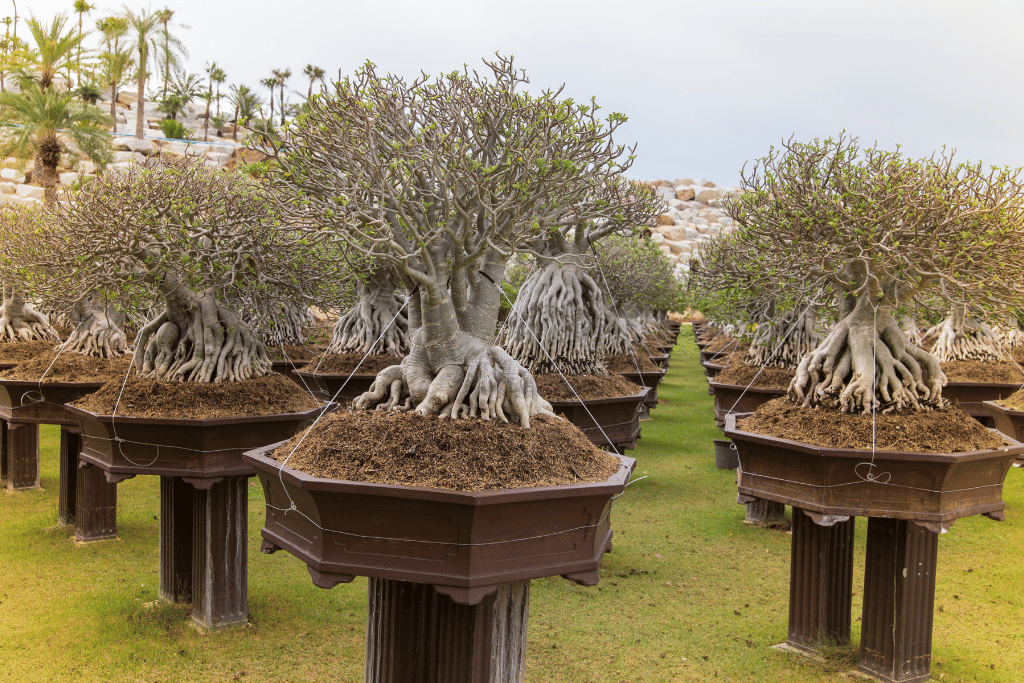
If your bonsai kit has supplied wire, you can also apply wire to shape the plant and train it to grow in a specific direction. There are many different styles you can apply to different species of plants, and some may not work with certain styles. It’s best to do your own research and look at other desert rose bonsai to see what you want to aim to achieve with your tree. You should note that it may take years and years to achieve what the images show you, though.
Step 5) Water and fertilize the plant
Many people need to give their desert rose bonsai more water, as they believe that a few drops or a minimal amount are enough to keep it healthy. Instead, you should water the plant thoroughly each time you water it. This ensures plenty of water reaches the roots—only water when the top inch of the soil has dried out.
I would recommend adding fertilizer to the soil to help the plant to grow. Feeding plants is critical for their survival and ensuring that they put on lots of beautiful and lush growth, so make sure you do this around once a week or once every two weeks. Follow the instructions on the fertilizer in the kit, and only apply the dosages it recommends; otherwise, you may risk burning the roots and damaging the plant.
Step 6) Monitor and care for the plant accordingly
While doing all these steps, it’s important that you monitor and care for your desert rose bonsai tree on a regular basis. This includes keeping up on watering your plant regularly, pruning and shaping as needed, and monitoring for any troubling signs or pests/diseases.
Watering: Desert rose bonsai should be watered when the soil is dry to the touch – it’s important not to overwater the plant; otherwise, this can lead to root rot. When watering your plant, make sure that you water the soil directly and avoid getting water on the leaves or the flowers, as this could promote the growth of nasty bacteria or fungi.
Pruning and shaping: Regular pruning and shaping are essential for keeping a bonsai tree looking like a bonsai tree. Pruning is also healthy for plants, and it promotes new growth! Use the pruning shears and wire included in your kit to shape the plant, which will allow you to train it to grow in a specific direction or style. It’s important to be patient when shaping your bonsai tree, though. as it can take months or years to achieve the desired shape that you want.
Pests and disease: Desert rose bonsai trees are, unfortunately, susceptible to a wide range of pests and diseases, including root rot, scale insects and spider mites. Regularly checking over your plants will help you to catch these problems early, from which you can then take steps to prevent them from spreading. If you notice any signs of pests or disease, you should take action immediately to prevent any further damage from occurring.
Step 7) Choosing a desert rose bonsai tree
If you’ve grown your desert rose bonsai tree successfully, you might be looking to expand your collection and buy another one – this time not from a bonsai tree kit. So, when selecting a desert rose bonsai tree, it’s important to select one that looks healthy and well-shaped. Look for a desert rose that has a thick and woody stem with healthy and glossy leaves. If it’s flowering, make sure that the flowers look to be in good condition without any defects. Avoid trees that have many yellow or brown leaves, as this is a sign that they may not be well taken care of or has an infestation of pests/disease.
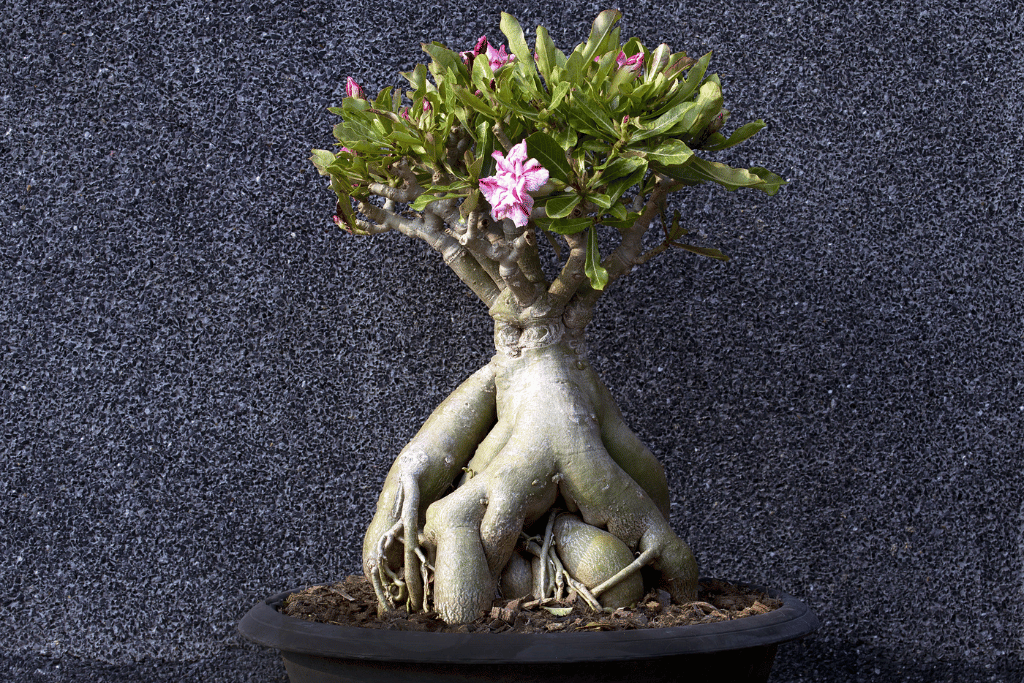
Step 8) Repotting a desert rose bonsai tree
Over time, you’ll find that the roots of your desert rose bonsai tree will have outgrown its pot. Roots may start to come out of the drainage holes, or the plant may even start to push itself out of the pot. To repot your bonsai tree, carefully remove it from its current pot, gently loosening the soil around the roots. Choose a bigger pot with a well-draining soil mix, such as akadama. Mound the soil in the middle of the pot, and push the tree down onto the soil. You can then fill in the remaining space with soil, using a chopstick to push the soil down into the roots. Water the plant thoroughly after this and place it in a location with bright and indirect light for a few weeks until it’s recovered.
Step 9) Shaping a desert rose bonsai tree
Shaping bonsai trees is a valuable skill that you’ll need to develop to start growing high-quality bonsai trees – especially if you want to display them at shows. Shaping bonsai trees is a delicate process that requires patience and attention to detail. You can start by pruning any branches or shoots which are growing in the wrong direction or interfering with the desired style/shape of the tree. Use an appropriate gauge of wire to gently bend and shape the remaining branches, and take care not to strip/damage any bark or remove any of the leaves. Over time, the tree will start to grow into the desired shape, and you can prune it and shape it as needed.
When you have applied wire, make sure that you keep a close eye on it. The trunk and branches will thicken in the growing season, and you’ll find that the wire will start biting into the bark. When this begins to happen, you should remove the wire with wire cutters. Don’t try and uncoil the wire, as this can damage the tree.
Step 10) Propagating desert rose bonsai trees
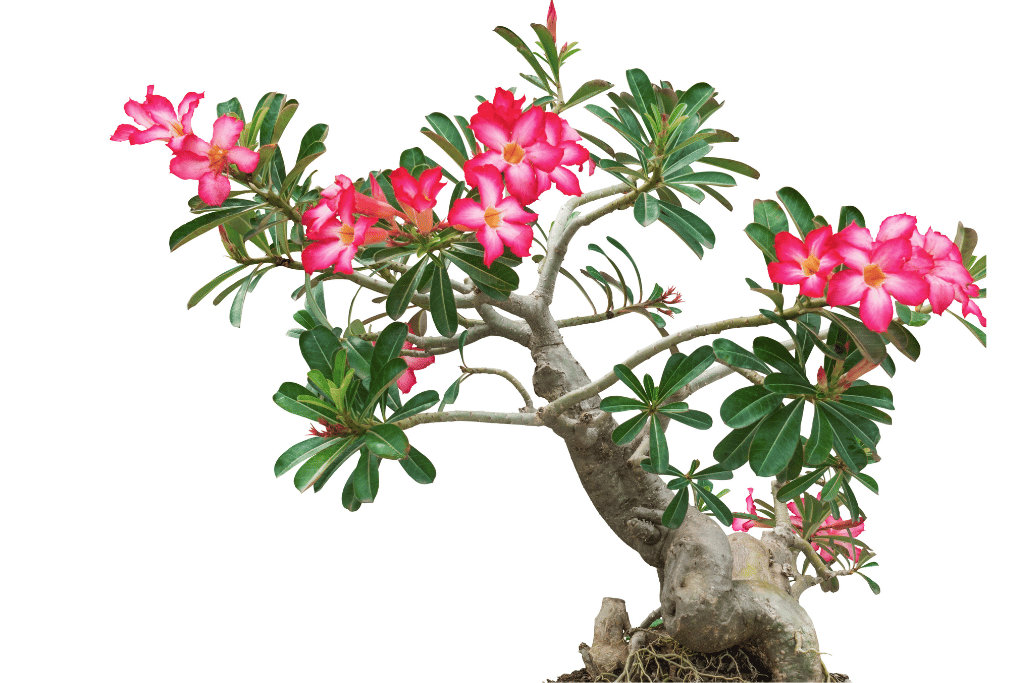
Propagating a desert rose bonsai tree involves taking a cutting from one of your trees and encouraging it to grow new roots, eventually becoming established to become its own plant. To propagate a desert rose bonsai tree, you should take a stem cutting from a branch of the plant. Remove leaves from the bottom half of the cutting, dipping the end of it in rooting hormone (this is optional, but may help) and plant it in well-draining soil. Keep the soil moist and provide lots of humidity with bright and indirect light, and the cutting should hopefully begin to grow roots within a few weeks.
Step 11) Common problems with desert rose bonsai trees
Desert rose bonsai trees are susceptible to a wide range of pests and diseases, which include root rot, spider mites and scale insects. Signs of pest infestation will include things such as spotted or discolored leaves, visible insects on the plant, or webbing around the branches or leaves. Signs of root rot will include the dropping of leaves, yellowing and wilting, as well as a foul smell from the soil and roots. To prevent and treat these problems, it’s important to monitor the plant and take good care of it, providing the proper amount of water and nutrition – taking action immediately if you notice any troubling signs.
Additional Tips: In addition to the regular watering, monitoring and pruning of your desert rose bonsai, there are a few other care tips to keep in mind when growing your tree. These include:
- Providing a good amount of sunlight: Desert rose bonsai trees need bright and direct sunlight to thrive, so they need to be planted in a location where they’ll receive plenty of natural light.
- Maintaining a consistent temperature: Desert rose bonsai trees prefer warm temperatures, and they should be kept away from drafts and extreme temperature fluctuations, which damage the plant and kill it.
- Repotting as needed: Over time, your desert rose bonsai tree will begin to outgrow its pot, and therefore it’ll require repotting. Keep an eye on the roots and size of the plant, and repot it when it’s needed to make sure it has enough room to grow. It would be best if you were going up pot sizes each time you repot unless it’s ready to start being trained to be placed in a bonsai pot.
- Using a humidity tray: Desert rose bonsai trees thrive in humid conditions, so it’s best to use a humidity tray to help maintain a consistent level of moisture in the air around your plant. Other factors, such as misting your tree, will help to keep the humidity up as well, meaning you’ll have a lovely and healthy desert rose bonsai.
Final Thoughts
Growing a desert rose bonsai tree is an excellent, rewarding and fun hobby for both experienced gardeners and beginners. With a desert rose bonsai kit, you’ll have everything you need to get started with that one plant, including a pre-bonsai tree, soil, a pot, pruning shears, fertilizer and wire. Though, as you progress in the hobby, you’ll find that you might want to buy some other supplies such as more soil, better tools and a wide variety of pots. By following the care tips I’ve outlined in this article, you can help your desert rose bonsai tree thrive and enjoy the stunning flowers for years to come.
It’s important to remember that growing a bonsai tree can take years and years; therefore, it requires time and patience. Don’t be discouraged if it takes a while to achieve a desired shape and size – and if a tree dies on you, remember what went wrong with it and use it as a learning experience. If you need help with what went wrong with it, why not ask someone you know who’s experienced with plants or use a bonsai forum? With dedication and proper care, your desert rose bonsai tree will become a unique and beautiful addition to your home or garden, which you can show off to your friends and family.
Frequently Asked Questions (FAQ)
What are desert rose bonsai trees?
A desert rose bonsai tree is a miniature version of the Adenium obesum plant, which is most commonly known as the desert rose. Desert rose plants are succulent plants which produce stunning flowers in a wide variety of colors, such as red, white and pink. Desert rose bonsai trees are known for their unusual and attractive shapes, which can be achieved through the careful shaping and pruning of them.
Can I grow a desert rose bonsai tree from seed?
Yes, it’s possible to grow desert rose bonsai trees from seed. It can be a slow and challenging process, so it’s often easier and more common to start with a pre-bonsai tree from a nursery or a bonsai kit. If you do decide to grow desert rose from seed, it’s important to follow the germination instructions carefully and be patient, as it can and will take several years for the plant to mature fully. Growing bonsai from seed into a high-quality tree can take decades of work!
How often do I need to water my desert rose bonsai tree?
Desert rose bonsai trees should ideally be watered when the soil is dry to the touch. This will depend on the climate and humidity levels in your area, meaning this could be once a week or every few days. It’s important not to overwater your plant; otherwise, this can lead to root rot which can be hard to treat and require a repot. If you think you’ve overwatered your tree, it’s best to reduce the watering frequency but still not let the soil fully dry out – as this can kill your tree just as fast (if not faster) than overwatering.
Do desert rose bonsai trees require special soil?
Preferably, desert rose bonsai trees will do better in well-draining soil that’s specifically formulated for succulent plants. This type of soil will allow water to drain through quickly, which is important for preventing root rot and stopping standing water from occurring. You can typically purchase bonsai soil at most garden centers or online – why not make your own mix with components such as sharp sand, akadama, pumice or other components?
How often should I fertilize my desert rose bonsai tree?
Desert rose bonsai trees should ideally be fertilized once a month in the growing season (spring and summer) with a fertilizer that is balanced in NPK (Nitrogen, Phosphorous and Potassium). Make sure to follow the instructions on the fertilizer carefully, as over-fertilizing can burn the roots of the plant and can cause it to die.


